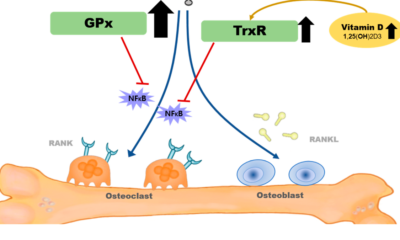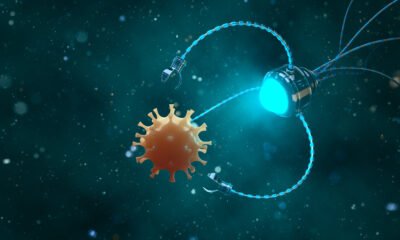Medical Sciences
Brain Clot Revolution, Vortex Ultrasound Tornado in Brain Health

Revolutionary Ultrasound Tornado Breaks Down Brain Blood Clots Faster
Researchers have introduced a groundbreaking tool that harnesses the power of “vortex ultrasound,” a unique form of ultrasonic energy resembling a tornado, to swiftly and effectively dismantle blood clots in the brain. This innovative approach, spearheaded by Xiaoning Jiang, the Dean F. Duncan Professor of Mechanical and Aerospace Engineering at North Carolina State University, and Chengzhi Shi, an assistant professor of mechanical engineering at Georgia Tech, showcases remarkable efficiency in clot elimination when compared to existing methods.
RESOURCED ARTICLE Ultrasonic “Tornado”: A New Faster Way To Break Down Blood Clots

Cerebral venous sinus thrombosis (CVST), a condition arising from blood clots in the veins responsible for draining blood from the brain, has been a challenging medical concern. In recent years, the incidence rates of CVST have seen an increase, reaching between 2 and 3 cases per 100,000 in the United States in 2018 and 2019.
The key to the success of this new tool lies in its utilization of vortex ultrasound, a technique where ultrasonic waves adopt a helical wavefront, creating a swirling motion as they move forward. This distinct motion induces shear stress, enhancing the efficiency of clot breakdown. In vitro testing simulating CVST using a 3D-printed model of the cerebral venous sinus and cow blood demonstrated a remarkable reduction in clot dissolution time. In contrast to pharmaceutical interventions, which typically take at least 15 hours and average around 29 hours, the vortex ultrasound method achieved clot dissolution in well under half an hour during the testing phase.

The significance of this accelerated clot elimination cannot be overstated, especially in cases of CVST where clots increase pressure on blood vessels in the brain. This heightened pressure escalates the risk of a potentially catastrophic brain hemorrhage. Existing treatments often rely on interventions that dissolve blood clots, but the time-consuming nature of these processes poses risks to patients. The vortex ultrasound approach, with its swift action, holds the potential to reduce these risks significantly.
Moreover, beyond the aspect of speed, the researchers emphasize the broader impact of their work. Current treatments for CVST fail in 20-40% of cases, highlighting the urgent need for alternative and more effective approaches.

The newly developed tool is not only innovative in its technique but also in its design. A single transducer, specifically engineered to produce the swirling vortex effect, constitutes the core of the tool. This transducer, small enough to be integrated into a catheter, can be navigated through the circulatory system to reach the precise site of the blood clot.
Addressing concerns about potential harm during catheterization, the researchers conducted experiments applying vortex ultrasound to animal blood vein samples. Encouragingly, these tests revealed no damage to the walls of the blood vessels. Additionally, assessments on red blood cells demonstrated minimal disruption, indicating the safety of the approach.
Looking ahead, the researchers plan to progress from in vitro testing to using an animal model to further establish the viability of this technique for CVST treatment. If successful, clinical trials will follow, marking a significant step toward making this innovative approach available for real-world applications.
READ MORE NEUROLOGY RELATED ARTICLE Decoding Brain Health, Hypertension’s Impact on Memory Unveiled

Importantly, Chengzhi Shi notes that if the vortex ultrasound becomes a clinical application, it is likely to be comparable in cost to other interventions used to treat CVST. This affordability factor, coupled with its demonstrated efficiency and safety, positions the ultrasound tornado technique as a promising avenue for addressing a critical medical challenge
Veterinary News
Blue tongue Alert: Norfolk Livestock Farmers Navigate New Challenges

Expanding Control Zones: Norfolk’s Battle Against Blue tongue Outbreak
Norfolk’s livestock farming community faces a heightened challenge as the bluetongue control zone expands in response to new cases of this potentially fatal animal disease. Bluetongue, affecting ruminants such as cattle, sheep, goats, deer, and camelids, has raised concerns after the confirmation of two infected cattle on a holding near Norwich. The total number of cases in the county has now reached 21 since the initial discovery on a Cantley farm in the Broads on December 8, signaling the need for increased vigilance and control measures.
RESOURCED ARTICLE Norfolk bluetongue control zone extended amid new cases

The regulatory authority in charge of such matters, the Department for Environment, Food & Rural Affairs (Defra), recently confirmed the extension of the temporary control zone (TCZ) in response to the latest developments. This 10-kilometer zone was initially established to facilitate focused surveillance efforts and restrict livestock movements, aiming to prevent the disease’s further spread. All preceding cases were contained within the TCZ, but the most recent instances involved animals grazing just outside the zone during a high-risk period. Consequently, the TCZ’s boundaries have been adjusted, extending it toward Norwich to address this evolving situation effectively.
An interesting departure from previous protocol is the decision not to cull the infected animals this time. Defra has opted for an alternative approach, restricting these animals at their current locations and implementing disease mitigation measures. This strategic shift is attributed to a recent reduction in midge activity, diminishing the risk of onward transmission. The link between bluetongue and infected midges is crucial to understanding its spread, as it is believed that the disease was introduced to Norfolk and Kent by these tiny vectors, carried across the Channel from Europe during optimal wind and temperature conditions in September or October.

However, despite the absence of evidence suggesting the disease’s circulation through midges in the UK, precautionary measures within the TCZ are causing disruption and uncertainty for local livestock farms. Specific licenses are now mandatory for moving animals out of the zone, with permission granted only under circumstances of “urgent and genuine welfare need” or for direct transportation to a designated abattoir. This has added an extra layer of complexity for farmers who must navigate these restrictions while ensuring the well-being of their livestock.
RAED MORE INFORMATIVE ARTICLE UK’s Milestone In Genetic Medicine,CRISPR Therapy Treating Sickle-Cell Disease and β-Thalassaemia

In conclusion, the expansion of the bluetongue control zone in Norfolk reflects the ongoing challenges in managing and preventing the spread of this disease. The decision to extend the TCZ, along with the nuanced approach to handling infected animals, showcases the dynamic nature of the situation. Livestock farmers must now contend with both the immediate implications of the disease and the regulatory hurdles imposed by specific licenses, emphasizing the need for a coordinated and adaptive response to safeguard the region’s agricultural interests. Stay informed, stay vigilant, and adhere to the evolving guidelines to ensure the well-being of both animals and the farming community
Medical Sciences
The Nexus of Coronavirus and the Nervous System

The outbreak of Severe Acute Respiratory Syndrome coronavirus 2 (SARS-CoV-2) has ushered in the unprecedented COVID-19 pandemic. Understanding the virus and its effects on the body, particularly the nervous system, is crucial in navigating these challenging times.
Introduction: Unveiling SARS-CoV-2 and COVID-19

Coronaviruses, typically linked to mild respiratory illnesses like the common cold, took an unexpected turn with the emergence of SARS-CoV-2, causing the global spread of COVID-19. This disease showcases a diverse range of symptoms, from mild discomfort to severe respiratory distress.
Neurological Impacts Unraveling the Connection
Research underscores that neurological symptoms associated with COVID-19 likely stem from the body’s immune response rather than direct viral invasion. Comprehensive studies analyzing cerebrospinal fluid have revealed the presence of antibodies, offering insights into the intricate interplay between the virus and neurological complications.
Immediate Effects on the Nervous System A Closer Look

While a significant proportion of individuals infected with SARS-CoV-2 experience mild symptoms, those requiring hospitalization often face brain-related complications. These can manifest as muscle aches, headaches, and, in severe cases, seizures or strokes. Understanding these immediate effects is paramount in providing holistic care to COVID-19 patients.
Vascular Complications and Blood Clots A Silent Threat
The virus’s interaction with receptors on blood vessel cells presents a silent threat, leading to vessel weakening, leakage, and microbleeds in the brain. Moreover, COVID-19 induces blood clot formation, heightening the risks of strokes, heart attacks, and organ damage. Maintaining optimal oxygen levels becomes imperative in preventing cognitive disorders and other severe consequences.
Recovery and Long Term Effects The Road to Healing
While a majority recover within weeks, a subset of individuals grapple with prolonged dysfunction across various body systems. The term “long COVID” encapsulates persistent symptoms, such as fatigue, cognitive difficulties, and pain. Recognizing and addressing these lingering effects is essential for promoting the well-being of those affected and informing future healthcare strategies.
Connection to Neurological Disorders Assessing Risk Factors
Individuals with pre-existing neurological conditions may confront an elevated risk of severe illness from COVID-19. Understanding the virus’s impact on the immune system emphasizes the need for vigilance in monitoring potential long-term complications, including stroke, dementia, and muscle and nerve damage.
Striking a Delicate Balance Navigating Neurological Safety in the Realm of COVID-19 Vaccines

In the current landscape of uncertainty, the COVID-19 vaccination stands out as a crucial tool in the prevention of severe illness. While the general consensus is that vaccines are safe, it’s essential to acknowledge that isolated instances of Guillain-Barre Syndrome have been associated with specific vaccine formulations.
The continuous vigilance exercised by authoritative bodies such as the Centers for Disease Control and Prevention (CDC) and the Food and Drug Administration (FDA) plays a pivotal role. This ongoing monitoring ensures that timely updates on vaccine safety are provided, effectively managing the delicate balance between safeguarding health and addressing potential risks.
The benefits of vaccination and the potential risks associated with certain formulations underscores the importance of remaining informed. Individuals are encouraged to stay abreast of the latest information from trusted health organizations, enabling them to make informed decisions about their well-being in the ongoing fight against COVID-19.
FOR MORE INTERESTING ARTICLES Transforming Heart Failure Care: Unveiling Abbott’s ARIES Trial Breakthrough with Aspirin-Free HeartMate 3
Conclusion
In the ever-changing landscape of the COVID-19 scenario, maintaining a well-informed perspective on the virus’s effects on the nervous system is of utmost importance. Building a strong foundation for comprehension involves identifying and applying pertinent keywords linked to SARS-CoV-2, COVID-19, and related subjects.
Amid the persistent challenges presented by COVID-19 globally, having a profound understanding of the virus’s impact on the nervous system becomes a source of empowerment for individuals, enabling them to make wise decisions about their health. The collective effort of staying informed and adhering to recommended guidelines allows us to collectively navigate the uncharted territories of this pandemic, striving towards a future characterized by improved health and unwavering resilience.
Medical Sciences
Nanodrones Against Cancer,UNIST’s Innovation Marks a New Era in Treatment

Game-Changer in Cancer Research: UNIST’s Nanodrones Take the Spotlight
In the realm of groundbreaking cancer treatment breakthroughs, the spotlight is now on the Ulsan National Institute of Science and Technology (UNIST), where a dynamic team of researchers has unveiled a potential game-changer. Imagine a world where tiny nanodrones, aptly named NK cell-engaging nanodrones (NKeNDs), take center stage in the fight against cancer.
RELATED ARTICLE New revolutionary nanodrones enable targeted cancer treatment

Led by the innovative minds of Professors Sebyung Kang and Sung Ho Park from the Department of Biological Sciences, this team has cracked the code to revolutionize cancer treatment. These nanodrones, far from the futuristic sci-fi portrayals, are engineered to specifically target and obliterate cancer cells, marking a significant leap forward in the battle against this relentless disease.

At the heart of this breakthrough lies the ability of these nanodrones to engage natural killer (NK) cells, the body’s frontline soldiers against cancer. What sets the NKeNDs apart is their precision – think of them as nanoscale guided missiles homing in on cancer cells with unparalleled accuracy. The secret sauce involves utilizing AaLS protein cage nanoparticles as the foundation for these nanodrones, incorporating specific cancer-targeting and NK cell-recruiting ligands, aptly named HER2 @NKeND and EGFR@NKeND.
Lab tests have showcased the remarkable ability of these nanodrones to selectively bind to various types of cancer cells while rallying NK cells to mount a defense against the invaders. The real breakthrough emerged during mice trials, where administering HER2 @NKeNDs alongside human immune cells resulted in a significant slowdown in tumor growth, all without adverse effects.

Professor Kang Se-byung, brimming with excitement, highlighted the potential for customizing treatments for different cancers using these NK cell delivery nanodrones. It’s not merely about targeting cancer cells; it’s about doing so with surgical precision, minimizing collateral damage and maximizing the impact of the body’s immune system.
MORE LATEST ARTICLE Brain Clot Revolution, Vortex Ultrasound Tornado in Brain Health
This groundbreaking study, published in Nano Today, marks a pivotal moment in scientific progress. With the support of various institutions dedicated to advancing knowledge, the door to a new era in cancer treatment swings wide open. Nanodrones may just be the superheroes we’ve been yearning for, offering hope and resilience in the face of one of humanity’s most formidable adversaries. As we raise a toast to science and innovation, the journey towards conquering cancer takes a remarkable leap forward. Cheers to the heroes of the microscopic world.
-

 Medical Sciences11 months ago
Medical Sciences11 months agoSelenium Nanoparticles Redefining Postmenopausal Osteoporosis Treatment with a Novel Approach
-

 Medical Sciences11 months ago
Medical Sciences11 months agoTransforming Heart Failure Care: Unveiling Abbott’s ARIES Trial Breakthrough with Aspirin-Free HeartMate 3
-

 Medical Sciences10 months ago
Medical Sciences10 months agoNanodrones Against Cancer,UNIST’s Innovation Marks a New Era in Treatment
-

 Medical Sciences11 months ago
Medical Sciences11 months agoGeriatric Care in the Face of Non-ST Elevated Myocardial Infarction and Acute Coronary Syndrome
-

 Blog11 months ago
Blog11 months agoUK’s Milestone In Genetic Medicine,CRISPR Therapy Treating Sickle-Cell Disease and β-Thalassaemia
-

 Medical Research11 months ago
Medical Research11 months agoA New Chapter in Vision Restoration By Rebuilding Retinal Ganglion Cells
-

 Blog11 months ago
Blog11 months agoCutting-Edge Diagnostic Technology Handheld Device for Alzheimer’s and Parkinson’s Diseases
-

 Medical Sciences10 months ago
Medical Sciences10 months agoDecoding Waardenburg Syndrome,Genetic Aspects and Clinical Nuances of Waardenburg Syndrome
